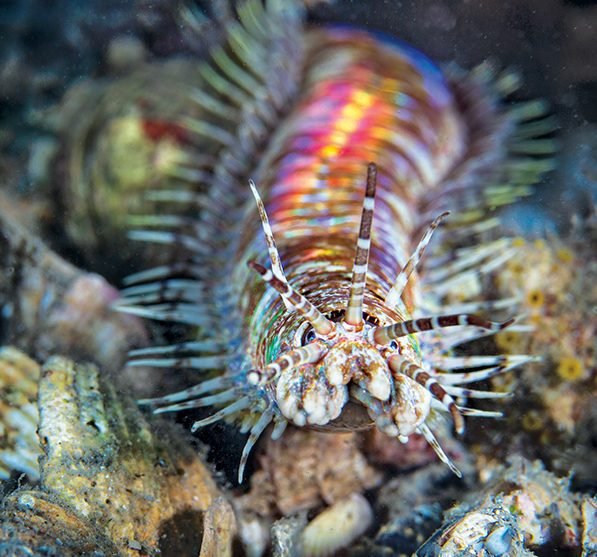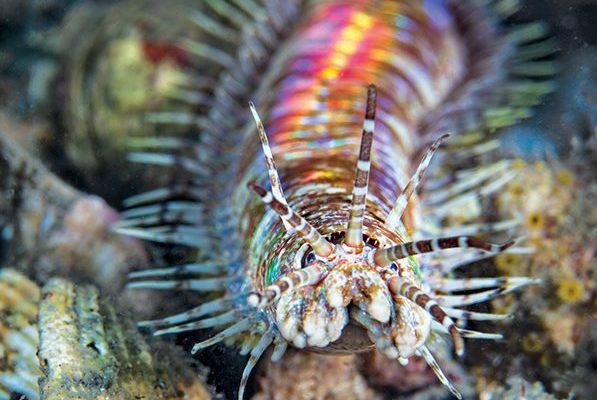
In this article, we’ll dive into the world of Bobbit worms, exploring their coloration and camouflage methods. Think of it as peeling back the layers of a vibrant fruit to see what’s inside. You’ll discover how these worms use their colors to blend into their surroundings, making them expert ambush predators. Let’s take a closer look at how they manage to be both eye-catching and hard to spot all at once.
What is a Bobbit Worm?
Before we dive deeper into their coloration and camouflage techniques, it’s essential to understand what a Bobbit worm is. These marine creatures belong to the family **Eunicidae** and are often found in sandy or muddy substrates in tropical and subtropical oceans. **Bobbit worms** are named after the infamous Lorena Bobbitt, not for any violent tendencies, but because they can “slice” their prey with their sharp jaws.
These worms have long, segmented bodies that can range in color from deep blues and greens to striking reds and purples. They can be quite elusive, burying themselves underground except for their colorful, spiny heads that stick out like a flower sharing its beauty. This distinctive appearance sets the stage for their remarkable camouflage abilities.
Coloration: The Beauty of Bobbit Worms
One of the first things you’ll notice about Bobbit worms is their stunning coloration. Their bodies can shimmer with iridescent hues, thanks to the tiny structures in their skin that reflect light. This striking coloration serves several purposes.
– Attracting Prey: Bright colors can lure in smaller fish curious enough to investigate. Imagine a party light shining in a dark room—many will be drawn to it, and that’s exactly what Bobbit worms exploit.
– Signal to Mates: During mating seasons, vibrant colors can indicate the health of a worm. A brighter hue often suggests a more robust and healthy specimen, making them more appealing to potential partners.
– Warning Colors: Some Bobbit worms are brightly colored as a warning. This can signal to predators that they are venomous or dangerous, helping to ensure their survival.
Understanding these aspects of their coloration helps us appreciate how important it is for their survival in the wild.
Camouflage Techniques of Bobbit Worms
When it comes to hiding from predators and sneaking up on prey, Bobbit worms are true masters of disguise. Their camouflage techniques are cleverly adapted to their environment, making them sophisticated hunters.
– Burrowing Behavior: Bobbit worms primarily hide in burrows, which they dig into the ocean floor. Their bodies are often covered with sand, silt, or small rocks that match their environment. This method allows them to remain concealed while venturing out to catch prey.
– Disruptive Coloration: The unique patterns and colors of a Bobbit worm’s body can break up its outline, making it harder for predators to spot them against the ocean floor. Think of it like a piece of art blending into a busy background; it’s much less noticeable when it shares visual elements with its surroundings.
– Movement Strategy: When hunting, Bobbit worms will often use a technique called *stealth*. They move very little, allowing them to blend into their environment seamlessly. When unsuspecting fish swim too close, they strike with lightning speed! This combination of stillness and sudden movement is key to their hunting technique.
These camouflage strategies not only help Bobbit worms stay hidden from predators but also help them catch their dinner!
How Coloration Influences their Habitat
Where Bobbit worms choose to live can significantly affect their coloration and camouflage. Generally, the brighter and more colorful the surroundings, the bolder the colors of the Bobbit worm tend to be.
– Coral Reefs: In colorful coral reef environments, Bobbit worms often display brighter hues. Their vibrant colors help them blend into the vibrant coral landscape while also attracting prey.
– Sandy Bottoms: In areas with mostly sandy substrates, Bobbit worms may exhibit more subdued, muted colors such as browns and greens. These tones allow them to remain hidden and avoid being spotted by larger predators.
– Environmental Changes: Bobbit worms can adapt to changes in their surroundings. For instance, if a coral reef begins to lose color due to environmental stress or bleaching, the worms may also exhibit changes in their coloration patterns to maintain effective camouflage.
Understanding how their habitat influences their coloration adds yet another layer to the beautiful and complex lives of Bobbit worms.
The Role of Color and Camouflage in Ecosystems
Bobbit worms are not just fascinating creatures; they play a vital role in their ecosystems. Their colorations and camouflage techniques affect not only their survival but also their interactions with other marine life.
– Predator-Prey Dynamics: By being both beautiful and well-camouflaged, Bobbit worms are able to ambush their prey efficiently. This affects local fish populations, as it keeps species numbers balanced.
– Biodiversity Indicators: Because their health and coloration can indicate the overall condition of the marine ecosystem, scientists often use Bobbit worms as indicators of environmental health, helping to monitor ocean conditions.
– Food Source: In turn, they serve as food for larger predators, contributing to the food web. Their presence or absence can provide insights into the health of the ecosystem as a whole.
Bobbit worms are truly an important thread in the intricate web of life in marine ecosystems.
Final Thoughts on Bobbit Worm Coloration and Camouflage Techniques
Bobbit worms are a brilliant example of nature’s creativity. Their stunning colors and clever camouflage techniques show how life evolves to adapt and survive. Whether they’re hiding from a predator or waiting for the right moment to strike, these worms are a testament to the secrets and beauty of the underwater world.
Next time you think about colorful sea creatures, remember the Bobbit worm and its unique features. They may not be the most famous marine animals, but they sure are captivating! The interplay of their vibrant colors and stealthy camouflage techniques makes them a fascinating subject worth studying.

